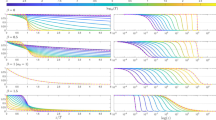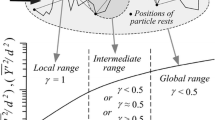Abstract
We analyze the impact of the boundary conditions on flow and transport solutions for the case of a two-dimensional heterogeneous medium with a linear trend in the mean log-conductivity. The influence of the boundaries is analyzed for different values of the domain size and aspect ratio, and different directions of the trend respect to the mean flow direction. The analysis involving a steady, spatially nonstationary velocity field, is developed by using the stochastic finite element method. Results of this study show that the impact of the trend in finite domains may disagree with that obtained in unbounded domains and it is more complex. The trend alters the result obtained for the medium with stationary conductivity, leading to a larger or smaller value of the macrodispersion coefficients, depending on the size and aspect ratio of the domain, and this effect may vary with the travel distance from the solute source. Moreover in limited domains here analyzed also for particles starting at distance of several integral scales from the boundaries and traveling in the middle of the domain, the behavior of macrodispersion coefficients is affected by the boundary conditions and the influence of the trend on longitudinal and transverse macrodispersion coefficients may vary with the imposed constraints.






Similar content being viewed by others
Abbreviations
- \(\mathbf {a}\) and \(\mathbf {b}\) :
-
Particle’s initial position (L)
- \(\mathbf {B}\) :
-
Matrix of the derivatives of the zeroth-order velocity along the mean particle path \((T^{-1})\)
- \(B_{ij}\) :
-
Element of the matrix \(\mathbf {B}\) \((T^{-1})\)
- \(\mathbf {C_{\mathbf {v}}}\) :
-
Velocity covariance matrix \((L^{2}T^{-2})\)
- \(\mathbf {d}\) :
-
Separation vector (L)
- \(\mathbf {D}\) :
-
Macrodispersion coefficient tensor \(L^{2}T^{-1}\)
- \(D_{ij}\) :
-
Macrodispersion coefficients \(L^{2}T^{-1}\)
- \(D_{11}\) and \(D_{22}\) :
-
Longitudinal and transversal macrodispersion coefficients \(L^{2}T^{-1}\)
- E :
-
Number of elements in which the domain is discretized
- \(\mathbf {E}\) :
-
Identity matrix \((-)\)
- K :
-
Hydraulic conductivity \((LT^{-1})\)
- \(K_{e}\) :
-
Hydraulic conductivity in the element e \((LT^{-1})\)
- \(K_{o}\) :
-
Zeroth-order hydraulic conductivity \((LT^{-1})\)
- \(K_{o,e}\) :
-
Zeroth-order hydraulic conductivity in the element e \((LT^{-1})\)
- \(L_{1}\) and \(L_{2}\) :
-
Domain sizes in the direction x and y (L)
- M :
-
Number of the intervals in which the time t is divided
- n :
-
Porosity (–)
- \(\mathbf {n}\) :
-
Outward unit vector normal to the boundary (L)
- \(\mathbf {q}\) :
-
Darcy velocity vector \((LT^{-1})\)
- \(\langle q_{1}\rangle \) :
-
Expected value of the Darcy velocity in the direction x \((LT^{-1})\)
- \(Q^{*}\) :
-
Prescribed flux on the boundary on \(\varGamma _{2}\) \((LT^{-1})\)
- t and \(t_{o}\) :
-
Particle’s tracking time (T) and initial time (T)
- \(t_{M}\), \(t_{m}\), \(t_{n}\) :
-
Time steps (T)
- \(\mathbf {v}\) :
-
Velocity vector \((LT^{-1})\)
- \(\mathbf {v_{o}}\) :
-
Zeroth-order velocity vector \((LT^{-1})\)
- \(v_{oi}\) :
-
Zeroth-order velocity in the i direction \((LT^{-1})\)
- \(\langle v_{1}\rangle \) :
-
Expected value of the velocity in the direction x \((LT^{-1})\)
- \(\mathbf {v'}\) :
-
Fluctuation of the velocity vector \((LT^{-1})\)
- \(\mathbf {x}\) :
-
Position vector (L)
- \(x_{1}\) and \(x_{2}\) :
-
x and y coordinates (L)
- \(\mathbf {X_{o}}\) :
-
Zeroth-order particle’s trajectory (L)
- \(X_{oj}\) :
-
Zeroth-order particle’s trajectory in the j direction(L)
- \(\mathbf {X'}\) :
-
Fluctuation of the particle’s trajectory (L)
- \(\langle \mathbf {X}'\mathbf {X}'\rangle \) :
-
Displacement covariance tensor \((L^{2})\)
- \(X_{ij}\) :
-
Element of the displacement covariance tensor \((L^{2})\)
- Y :
-
Hydraulic log-conductivity (–)
- \(\langle Y\rangle \) :
-
Expected value of the log-conductivity (–)
- \(\langle Y'_{j}Y'_{\ell }\rangle \) :
-
Element of the covariance matrix of the log-conductivity (–)
- \(Y_{o}\) :
-
Prescribed constant log-conductivity (–)
- \(\alpha _{1}\) :
-
Multiplicative coefficient of the log-conductivity in direction x (–)
- \(\alpha _{2}\) :
-
Multiplicative coefficient of the log-conductivity in direction y (–)
- \(Y_{e}\), \(Y_{j}\), \(Y_{\ell }\) :
-
Log-conductivity in the element e, j and \(\ell \) (–)
- \(Y'_{j}\) and \(Y'_{\ell }\) :
-
Fluctuation of the log-conductivity in the element j and \(\ell \) (–)
- \(\varGamma \) :
-
Boundary of the domain (L)
- \(\varGamma _{1}\) :
-
Dirichlet boundary segments (L)
- \(\varGamma _{2}\) :
-
Neumann boundary segments (L)
- \(\Delta t\) :
-
Duration of the time interval (T)
- \(\epsilon \) :
-
Aspect ratio of the domain \((-)\)
- \(\lambda \) :
-
Correlation length of the log-conductivity (–)
- \(\xi \) :
-
Weight function
- \(\rho _{Y}\) :
-
Correlation function of the log-conductivity (–)
- \(\sigma _{Y}^{2}\) :
-
Variance of the log-conductivity (–)
- \({\varPhi }\) :
-
Piezometric head (L)
- \({\varPhi }^{*}\) :
-
Prescribed piezometric head on the boundary \(\varGamma _{1}\) (L)
- \({\varPhi }_{o}\) :
-
Zeroth-order piezometric head (L)
- \(\varvec{\Psi }\) :
-
State transition matrix \((-)\)
- \(\varvec{\Psi }^\mathbf{{T}}\) :
-
State transition matrix transpose \((-)\)
- \(\omega \), \(t'\), \(t''\) :
-
Variables of integration
- \({\varOmega }\) :
-
Flow domain \((L^{2})\)
- \({\varOmega }_{e}\) :
-
Area of the element e of the discretized domain \((L^{2})\)
- \(\big |_{o}\) :
-
Value computed at the zeroth-order
References
Bellin, A., Salandin, P., Rinaldo, A.: Simulation of dispersion in heterogeneous porous formations: statistics, first-order theories, convergence of computations. Water Resour. Res. 28(9), 2221–2227 (1992)
Brogan, W.L.: Modern Control Theory. Prentice Hall, Upper Saddle River (1991)
Dagan, G.: Flow and Transport in Porous Formations. Springer, New York (1989)
Darvini, G.: An example of solute spreading in nonstationary, bounded geological formations. Stoch. Environ. Res. Risk Assess. 28, 297–306 (2014). doi:10.1007/s00477-013-0749-3
Darvini, G., Salandin, P.: An approach to subsurface transport in statistically inhomogeneous velocity fields. Dev. Water Sci. 55(Part 1), 743–754 (2004). doi:10.1016/S0167-5648(04)80096-0
Darvini, G., Salandin, P.: Nonstationary flow and non-ergodic transport in random porous media. Water Resour. Res. 42(W12), 409 (2006). doi:10.1029/2005WR004846
Darvini, G., Salandin, P.: Effective dispersion in conditioned transmissivity fields. Adv. Water Resour. 74, 279–289 (2014). doi:10.1016/j.advwatres.2014.09.013
Eggleston, J., Rojstaczer, S.: Identification of large-scale hydraulic conductivity trends and the influence of trends on contaminant transport. Water Resour. Res. 34, 2155–2168 (1998)
Guadagnini, A., Guadagnini, L., Tartakovsky, D.M., Winter, C.L.: Random domain decomposition for flow in heterogeneous stratified aquifers. Stoch. Environ. Res. Risk Assess. 17, 394–407 (2003)
Indelman, P., Rubin, Y.: Flow in heterogeneous media displaying a linear trend in the log conductivity. Water Resour. Res. 31(5), 1257–1265 (1995)
Indelman, P., Rubin, Y.: Solute transport in nonstationary velocity field. Water Resour. Res. 32(5), 1257–1265 (1996)
Lessoff, S.C., Indelman, P., Dagan, G.: A note on the influence of a constant velocity boundary condition on flow and transport in heterogeneous formations. Water Resour. Res. 36(10), 3095–3101 (2000)
Lu, L., Zhang, D.: Solute spreading in nonstationary flows in bounded, heterogeneous unsaturated–saturated media. Water Resour. Res. 39(3), 1049 (2003). doi:10.1029/2001WR000908
Lu, Z., Wolfsberg, A.V., Dai, Z., Zheng, C.: Characteristics and controlling factors of dispersion in bounded heterogeneous porous media. Water Resour. Res. 46(W12), 508 (2010). doi:10.1029/2009WR008392
Morales-Casique, E., Neuman, S.P., Guadagnini, A.: Nonlocal and localized analyses of nonreactive solute transport in bounded randomly heterogeneous porous media: computational analysis. Adv. Water Resour. 29, 1399–1418 (2006)
Osnes, H.: Stochastic analysis of velocity spatial variability in bounded rectangular heterogeneous aquifers. Adv. Water Resour. 21, 203–215 (1998)
Rubin, Y.: Stochastic modeling of macrodispersion in heterogeneous porous media. Water Resour. Res. 26(1), 133–141 (1990)
Rubin, Y., Dagan, G.: Stochastic analysis of boundaries effect on head spatial variability in heterogeneous aquifers, 1. Constant head boundary. Water Resour. Res. 24(10), 1689–1697 (1988)
Rubin, Y., Dagan, G.: Stochastic analysis of boundaries effect on head spatial variability in heterogeneous aquifers, 2. Impervious boundary. Water Resour. Res. 25(4), 707–712 (1989)
Rubin, Y., Seong, K.: Investigation of flow and transport in certain cases of nonstationary conductivity fields. Water Resour. Res. 30(11), 2901–2911 (1994)
Seong, K., Rubin, Y.: Field investigation of the waste isolation pilot plant (WIPP) site (New Mexico) using a nonstationary stochastic model with a trending hydraulic conductivity field. Water Resour. Res. 35(4), 1011–1018 (1999)
Severino, G.: Macrodispersion by source flows in randomly heterogeneous porous media. Transp. Porous Media 89, 121–134 (2011a)
Severino, G.: Stochastic analysis of well-type flows in randomly heterogeneous porous formations. Water Resour. Res. 47, W03520 (2011b). doi:10.1029/2010WR009840
Winter, C.L., Tartakovsky, D.M., Guadagnini, A.: Moment differential equations for flow in highly heterogeneous porous media. Surv. Geophys. 24(1), 81–106 (2003)
Zhang, D., Andricevic, R., Alexander, Y.S., Hu, X., He, G.: Solute flux approach to transport through spatially nonstationary flow in porous media. Water Resour. Res. 36(8), 2107–2120 (2000)
Acknowledgments
This work was supported by the Contributo per la Ricerca Scientifica di Ateneo of the Università Politecnica delle Marche. The author wants to thank the reviewers for their thoughtful comments.
Author information
Authors and Affiliations
Corresponding author
Rights and permissions
About this article
Cite this article
Darvini, G. The Boundaries Influence in Trending Hydraulic Conductivity Fields. Transp Porous Med 113, 471–490 (2016). https://doi.org/10.1007/s11242-016-0705-z
Received:
Accepted:
Published:
Issue Date:
DOI: https://doi.org/10.1007/s11242-016-0705-z




